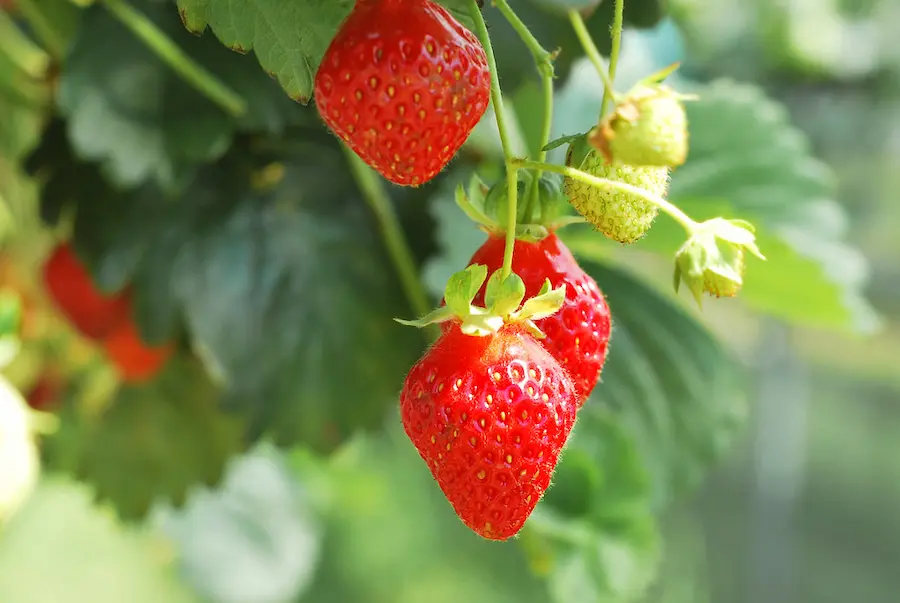Proper spacing between strawberry plants and rows enables healthy plant growth and optimal berry yields. It also allows for crown growth, air circulation, and easy harvesting. Many strawberries are produced in California each year using suitable spacing techniques. Here is more information about optimal strawberry farming spacing and why it’s important:
Table of Contents
Understanding Spacing in Strawberry Farming
Strawberries spread via runners, with each daughter plant needing its own territory. Planting too densely crowds runners together. This can prevent the daughter plants from rooting and developing properly. Tight spacing can also create a tangled mat of plants all competing for resources like water and sunlight.
The recommended spacing between plants may depend on the chosen strawberry farming system. California produces over 80% of the strawberries grown in the United States. Hundreds of family strawberry farms up and down the central and southern California coast supply America with its favorite fruit, often favoring raised-bed plasticulture. This planting system’s average spacing between plants is 12-14 inches. This allows each crown ample space to reach full size and daughter plants room to establish. At maturity, the leaves and crowns of properly spaced plants will just touch each other. This forms a dense canopy without crowding the roots.
Planting rows are typically spaced 3-4 feet apart. The alleyways between rows are needed for air circulation, maintenance, and harvesting. Workers and equipment need to move through easily. Narrower rows become congested, while wider rows waste precious growing space. The 3-4 foot width optimizes planting density and mobility.
Prevent Stunted Plant Growth
Strawberries planted too close together may experience stunted growth. The plants may struggle to thrive with crowded root systems competing for nutrients and water. Reduced root development can also equal less energy reserves for making runners and flowers. Tightly packed plants stretch upward, competing for sunlight. Such plants may produce fewer fruits, and the berries tend to be smaller.
Proper 12-14 inch spacing allows each crown sufficient access to water, nutrients, and sunlight. This spacing enables full, robust plant development above and below ground. The result is often higher yields of large, juicy berries.
Allow Air Circulation
Sufficient spacing between strawberry plants allows air to flow through the rows. Good air circulation promotes plant health and productivity, while crowded plantings block airflow. The crowded leaves can create a moist habitat ideal for fungal and bacterial diseases.
Poor air movement also allows pests like spider mites to multiply rapidly. Proper spacing creates open channels between plants. The constant airflow can dry any dew on leaves, which may help fight diseases and make it difficult for pests to establish themselves on plants.
Make Harvesting Easier
Trying to pick ripe strawberries from a tangled mass of overcrowded plants can be difficult. The plants intertwine, making it hard to spot ready berries. Growers may risk damaging plants trying to reach into dense foliage. Adequate plant spacing creates nice straight rows with good visibility. Workers can more easily move down the open rows, scanning for ripe fruit. With proper spacing, most berries can be harvested without overly touching the plants.
Allow Daughter Plants To Establish
Strawberry plants propagate by sending out runners that form new daughter plants. These daughter plants then make their own runners, continuing the process. Overcrowded strawberries have nowhere for the runners to go. Runners crisscross over each other, tangling into knots. The daughter plants at the end of the runners may be unable to find space to root themselves. These unrooted daughter plants drain resources from the mother plant without contributing any yields. Adequate 12-14 inch spacing gives each daughter plant space to establish. The rooted daughters can then mature into full-sized, productive plants extending the planting rows.
Encourage Strawberry Plant Growth Through Adequate Spacing
Proper spacing is a farming practice that California strawberry farmers can utilize to help maximize yields on limited acreage. Following spacing techniques of 12-14 inches between plants and 3-4 feet between rows can support vigorous, high-yielding plants at a density that fully utilizes the available space. Learn more about the recommended strawberry farming spacing guidelines for optimized plant health and berry production.

